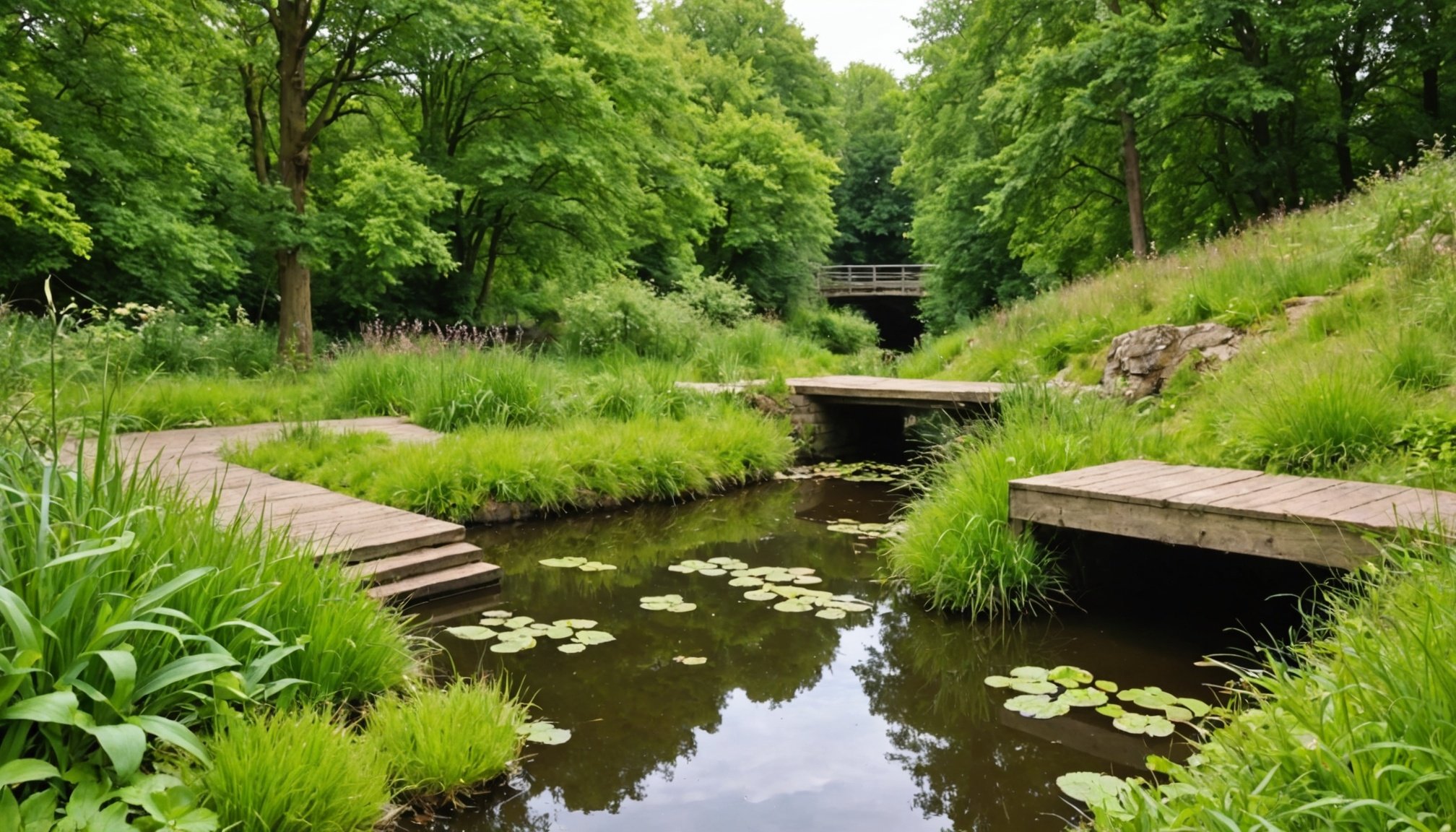The Importance of Urban Green Sanctuaries for Amphibians
Urban green sanctuaries are crucial in combating the decline of amphibians, whose habitats face significant threats from pollution, habitat destruction, and climate change. Amphibian habitats within urban environments serve as vital refuges for these sensitive species, supporting biodiversity conservation, and enhancing urban ecosystems. By integrating natural spaces into cities, we create environments where amphibians and humans can thrive.
Amphibians are acknowledged as bioindicators, meaning their presence and health reflect the overall status of an ecosystem. These creatures are excellent at controlling pest populations, contributing significantly to ecological balance. Supporting their existence through urban green sanctuaries aids in nurturing a resilient and healthy urban ecosystem, offering a plethora of benefits to both wildlife and human inhabitants.
Topic to read : Transforming uk urban gardens: creative approaches to enhance pollinator habitats and combat declines
Dedicated amphibian-friendly habitats in urban areas are fundamental. These environments must include features like water bodies, shaded areas, and diverse plant life to mimic natural habitats. By doing so, these sanctuaries not only support amphibian life cycles but also enrich urban biodiversity. As a result, urban planners and communities must prioritize the creation and maintenance of such sanctuaries to protect these essential species while fostering a symbiotic relationship between nature and urban living.
Designing Amphibian-Friendly Green Spaces
Designing amphibian-friendly habitats involves specific principles crucial for creating thriving ecosystems. Effective habitat requirements focus on water availability, natural landscapes, and temperature regulation. These elements not only cater to amphibian needs but enhance urban biodiversity as a whole.
In the same genre : Boosting uk farming: eco-friendly strategies to safeguard barn owl populations
Key Design Elements for Amphibian Habitats
The design must intertwine water features, such as ponds or streams, with varied natural landscapes. This combination provides essential breeding grounds and shelters for amphibians. Additionally, ensuring moisture retention through natural shading and vegetation aids in maintaining suitable microclimates crucial for their survival.
Incorporating Water Features and Natural Landscapes
Water features are central to design principles, serving as essential components for amphibian breeding and development. They also attract other wildlife, boosting the ecological value of urban spaces. The integration of native plant species further supports this, providing food sources and shelter from predators.
Creating Diverse Microhabitats for Various Species
Urban planning should prioritize diverse microhabitats, catering to multiple amphibian species’ needs. These habitats, rich in vegetation and humidity, simulate natural environments. Including logs, rocks, and leaf litter creates microclimates that regulate temperature, ensuring amphibians thrive despite urban variations.
Ecological Benefits of Amphibian-Centric Urban Sanctuaries
Urban green spaces that focus on amphibian habitats offer numerous ecological benefits, promoting healthier urban environments. Amphibians play a critical role in pest control, acting as natural regulators within the ecosystem. By controlling insect populations, they help reduce the need for chemical pesticides, thus contributing to a more sustainable urban ecosystem.
Additionally, amphibians are a vital component in maintaining ecological balance. Their presence indicates a healthy environment, and their absence can signal potential ecological issues. Hosting a diverse range of amphibian species in urban green sanctuaries directly benefits environmental health by supporting biodiversity and providing essential ecosystem services.
Urban sanctuaries provide interconnected benefits that ripple through local ecosystems, supporting other wildlife species. The creation of diverse and richly vegetated microhabitats also attracts birds, small mammals, and insects, further enhancing urban biodiversity. Consequently, these spaces not only serve amphibians but also bolster the broader ecological network, underlining their importance in urban planning.
Investing in amphibian-centric sanctuaries not only aids in conserving these sensitive species but also paves the way for robust and resilient urban ecosystems that benefit both wildlife and human populations.
Community Engagement and Education
Numerous programmes can increase community involvement in amphibian conservation efforts. Engaging local residents in habitat creation not only fosters environmental awareness but also galvanises support for urban green sanctuaries. These interactions promote stewardship through hands-on activities like planting native flora or constructing amphibian habitats in public spaces.
Engaging Local Residents in Habitat Creation
Effective community engagement strategies focus on collaborating with neighbourhood groups and organisations. Offering workshops and participatory activities can drive environmental awareness, encouraging residents to promote and sustain local biodiversity conservation. The outcome is a community invested in safeguarding urban ecosystems.
Educational Initiatives for Schools and Organizations
Educational programs serve a pivotal role in introducing the next generation to amphibian-centric themes. Providing schools and nonprofits with educational materials and classroom activities can create a deeper understanding of urban green sanctuaries. Such initiatives not only educate about these species but illustrate their vital roles in maintaining vibrant ecosystems.
Volunteer Programs for Habitat Maintenance
Implementing volunteer programs is key to sustaining urban sanctuaries over time. By creating partnerships with local community groups, volunteers can engage in habitat maintenance tasks, such as monitoring amphibian populations or tending to the environment. These opportunities empower individuals to take an active role, enriching the community’s commitment to ecological harmony.
Case Studies of Successful Urban Green Sanctuaries in the UK
Exploring successful case studies of urban green sanctuaries within the UK reveals insightful strategies for creating effective amphibian habitats. Several projects highlight the transformative impact of dedicated urban spaces on amphibian populations, offering replicable models for other regions.
Overview of Notable UK Projects
In the UK, initiatives like the London Wetland Centre and the Gunnersbury Triangle have set benchmarks in urban conservation. These projects integrate water bodies and native plant species, promoting adaptive design principles that foster thriving amphibian populations. Their design reflects a clear understanding of habitat management, offering valuable lessons on merging urban environments with natural ecosystems.
Key Learnings and Best Practices
These projects underscore the importance of creating diverse microhabitats and ensuring continuous habitat management. A focus on environmental policy and community involvement emerges as pivotal for project success. Local authorities prioritise habitat features that cater to amphibians’ specific needs, ensuring a sustainable blend between urban planning and biodiversity conservation.
Impact Assessment
The positive ripple effect of these urban sanctuaries is evident in increased amphibian numbers and enhanced urban biodiversity. Systematic monitoring and community engagement have been instrumental in these outcomes, showcasing the power of collaborative implementation strategies in achieving long-term success and ecological harmony.
Guidelines for Implementing Amphibian-Friendly Practices
Urban environments offer unique challenges and opportunities in creating thriving spaces for amphibians. Practical implementation strategies pave the way for successful integration of green sanctuaries, promoting habitat management and supporting biodiversity. Urban planners and local governments must prioritize innovative environmental policy to protect these vital ecosystems.
Policy Recommendations for Urban Planning
Policies should focus on preserving existing natural areas and integrating green spaces into urban development plans. Municipalities could establish zoning laws that incentivize green building practices, ensuring that urban green sanctuaries are included in new projects. Developing partnerships with environmental organizations can foster effective policy development, aligning urban growth with ecological preservation.
Best Practices for Ongoing Habitat Management
Successful habitat management requires regular maintenance and adaptive approaches to meet changing environmental conditions. Urban planners should employ strategies like native plant species utilization and microhabitat diversity to sustain ecological integrity. Engaging the community in these practices ensures long-term enthusiasm and commitment to these green sanctuaries.
Monitoring and Evaluating Habitat Success
Robust data collection is vital for assessing the effectiveness of implemented strategies. Monitoring amphibian populations and evaluating the impacts on local biodiversity enable continuous improvement for these habitats. Regular assessments can guide necessary adjustments, ensuring that amphibian-friendly habitats continue to thrive amidst evolving urban landscapes.











